Today Current Affairs: 23rd January 2021 for UPSC IAS exams, State PSC exams, SSC CGL, State SSC, RRB, Railways, Banking Exam & IBPS, etc
Table of Contents
Google-French Deal:

Google has signed a deal with a group of French publishers to make digital copyright payments for online news content.
- A similar tussle is ongoing between the Australian government and global tech platforms (google and Facebook) over the sharing of royalties with news publishers.
About the Google-French Deal:
- France became the first country to enshrine the European Union copyright rules into national law.
- This brought into effect the ‘neighboring rights’ law.
- Neighboring Rights: According to the World Intellectual Property Organization (WIPO), neighboring rights protect the legal interests of certain persons and legal entities that contribute to making works available to the public or that produce subject matter which, while not qualifying as works under the copyright systems of all countries, contains sufficient creativity or technical and organizational skill to justify recognition of a copyright-like property right.
- The newly adopted EU directive ensures that media are paid for original content, typically news, offered online by tech giants such as Google and Facebook.
- Under the new law, Google was forced to negotiate to pay the publishers and news agencies for reusing their material online.
European Union Copyright Rules:
- It wants to create a comprehensive framework where copyrighted material, copyright holders, publishers, providers and users can all benefit from clearer rules, adapted to the digital era.
The focus is on three main objectives:
- Wider opportunities to use copyrighted material for education, research, and preservation of cultural heritage.
- More cross-border and online access for citizens to copyright-protected content.
- Fairer rules for a better-functioning of copyright marketplace which stimulates creation of high-quality content.
Issues in Australia:
- Google has threatened to remove its search engine from the country, and Facebook has said it could block Australian users from posting or sharing news links if proposed norms on royalty payments are rolled out.
- Royalty payment: A royalty is a legally-binding payment made to an individual, for the ongoing use of his or her originally-created assets, including copyrighted works, franchises, and natural resources.
The argument made by the global tech companies is that:
- The Australian media industry is already benefiting from traffic being routed to them by each of the digital platforms.
- The new rules proposed by the Australian authorities would expose them to unmanageable levels of financial and operational risk.
- Hefty fines proposed by authorities are being seen as an added disincentive.
- The fundamental difference in the approach taken by the French and Australian authorities on the issue is that France specifically linked payments to copyright, without putting a forcing device into the agreements like in Australia.
4-Tier Structure for Regulation of NBFCs:
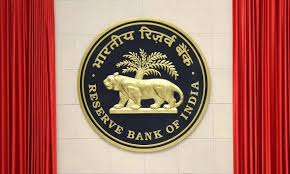
The Reserve Bank of India (RBI) has proposed a tighter regulatory framework for Non-Banking Financial Companies (NBFCs) by creating a four-tier structure with a progressive increase in the intensity of regulation.
It has also proposed the classification of Non-Performing Assets (NPAs) of base layer NBFCs from 180 days to 90 days overdue. Earlier in 2020, the RBI announced a host of measures to provide liquidity support to NBFCs. The Department of Non-Banking Supervision (DNBS) of RBI is entrusted with the responsibility of regulation and supervision of NBFCs under the regulatory – provisions contained under Chapter III B and C and Chapter V of the Reserve Bank of India Act, 1934.
- The Regulatory and Supervisory Framework of the Reserve Bank provides for, among other things, registration of NBFCs, prudential regulation of various categories of NBFC, issue of directions on acceptance of deposits by NBFCs and surveillance of the sector through off-site and on-site supervision.
- Deposit-taking NBFCs and Systemically Important Non-Deposit Accepting Companies are subjected to a greater degree of regulation and supervision.
- The focus of regulation and supervision is threefold, viz., a) depositor protection, b) consumer protection and c) financial stability.
- The RBI has also been empowered under the RBI Act 1934 to take punitive action which includes cancellation of Certificate of Registration, issue of prohibitory orders from accepting deposits, filing criminal cases or winding up petitions under provisions of Companies Act in extreme cases.
Aim:
- The proposed framework is aimed at protecting financial stability while ensuring that smaller NBFCs continue to enjoy light regulations and grow with ease.
Proposed Classification of NBFC (The Four-Tier Structure): The regulatory and supervisory framework of NBFCs should be based on a four-layered structure:
- Base Layer:
- NBFCs in the lower layer will be known as NBFC-Base Layer (NBFC-BL).
- For NBFCs in this layer least regulatory intervention is warranted.
- Middle Layer:
- NBFCs in the middle layer will be known as NBFC-Middle Layer (NBFC-ML)
- The regulatory regime for this layer will be stricter compared to the base layer.
- Adverse regulatory arbitrage vis-à-vis banks can be addressed for NBFCs falling in this layer in order to reduce systemic risk spill-overs, where required.
- Upper Layer:
- NBFC in the Upper Layer will be known as NBFC-Upper Layer (NBFC-UL) and will invite a new regulatory superstructure.
- This layer will be populated by NBFCs which have large potential of systemic spill-over of risks and have the ability to impact financial stability.
- There is no parallel for this layer at present, as this will be a new layer for regulation.
- The regulatory framework for NBFCs falling in this layer will be bank-like, albeit with suitable and appropriate modifications.
- If an identified NBFC-UL does not meet the criteria for classification for four consecutive years, it will move out of the enhanced regulatory framework.
- Top Layer:
- Ideally this layer is supposed to be empty.
- It is possible that supervisory judgment might push some NBFCs out of the upper layer of the systemically significant NBFCs for higher regulation/supervision.
- These NBFCs will occupy the top of the upper layer as a distinct set. Ideally, this top layer of the pyramid will remain empty unless supervisors take a view on specific NBFCs.
- If certain NBFCs lying in the upper layer are seen to pose extreme risks as per supervisory judgment, they can be put to higher and bespoke regulatory/supervisory requirements.
Non-Banking Financial Company (NBFC):
- A Non-Banking Financial Company (NBFC) is a company registered under the Companies Act, 1956 engaged in the business of loans and advances, acquisition of shares/stocks/bonds/debentures/securities issued by Government or local authority or other marketable securities of a like nature, leasing, hire-purchase, insurance business, chit business but does not include any institution whose principal business is that of agriculture activity, industrial activity, purchase or sale of any goods (other than securities) or providing any services and sale/purchase/construction of the immovable property.
- A non-banking institution which is a company and has principal business of receiving deposits under any scheme or arrangement in one lump sum or in installments by way of contributions or in any other manner is also a non-banking financial company (Residuary non-banking company).
Environment Protection Act, 1986:
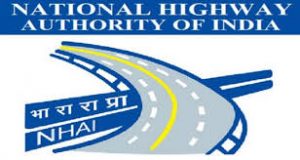
The National Highways Authority of India (NHAI) in the Karnataka High Court claimed that the Environment Protection Act, 1986 was passed by Parliament not only for protection of environment but also at the instance of foreign powers.
- A writ petition filed by the NGO, United Conservation Movement, against a 2013 notification of the Union Environment Ministry doing away with environment impact assessment reports for widening national highways of over 100 km by more than 40 metres.
- The United Conservation Movement is a conglomeration of environmental groups, and has over the last couple of years challenged NHAI projects in the Western Ghats, a tiger reserve as well as construction activity in a wildlife reserve.
NHAI’s Claim:
- NHAI also alleged that many NGOs file petitions for upholding the norms of the Act at the instance of foreign powers.
Foreign entities such as Amnesty International and Peoples Union for Civil liberties through its Indian counterparts have filed Writ Petitions under Article 32 of the Constitution of India. - Article 32 of the Constitution (Right to Constitutional Remedies): It is a fundamental right, which states that individuals have the right to approach the Supreme Court (SC) seeking enforcement of other fundamental rights recognised by the Constitution.
- The submission alleges that many organisations in India, which function as environmental action and human rights, are actively involved in attacking development projects, and challenging the government. policies & notifications and doing anti national activities.
- The Environment Protection Act, 1986 is an Act that was influenced by the United Nations Conference on the Human Environment held at Stockholm in June, 1972 (Stockholm Conference)
- Hence, the Act has been passed by Parliament not only for protection of the environment but also at the instance of foreign powers.
Court’s Ruling:
- The High Court has directed the NHAI chairman to nominate a very senior officer to look into and inquire into the manner in which the statement of objections was filed.
- The High Court has also asked the NGO, United Conservation Movement, to provide details of its constitution and activities carried out in environment and conservation.
Khelo India Youth Games:
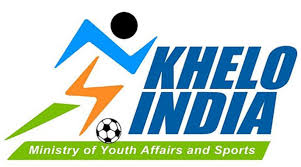
Four indigenous martial art forms included in Khelo India Youth Games:
- The Khelo India Youth games were launched in 2018 as a multidisciplinary grassroots event for under-17 years and under-21 years.
- Conducted annually, the best performers are given an annual scholarship of ₹5 lakh for eight years to prepare for international sporting events.
- In a recent move, the Sports Ministry inducted four indigenous martial art forms — Kalaripayattu of Kerala, Mallakhamb of Central India, Gatka of Punjab and Thang-ta of Manipur — into the Khelo India Youth Games (KIYG).
Mallakhamb:
- It is a traditional form of gymnastics performed with a wooden pole (made of wood from sheesham or Indian rosewood and polished with castor oil), a cane, or a rope.
- Though Madhya Pradesh declared Mallakhamb the State sport only in 2013, it had been developed as a competitive sport since 1981, with rules and regulations introduced at the first National Championship that year.
Gatka:
- It is a style of fighting with wooden sticks that originated in Punjab in the 15th Century.
- The bana and chola are worn for ritualistic performances but when performed as a sport, the practitioner wears track pants and T-shirt, and the stick is no longer the size of a man.
Thang Ta:
- It is a Manipuri art form.
- It combines ritual, demonstration and combat and involves a variety of dance forms and warrior drills.
Kalaripayattu:
- It is a Martial art which originated as a style in Kerala during 3nd century BC to the 2nd century AD.
- The word kalari first appears in Sangam literature to describe both a battlefield and combat arena.
- It is also considered to be one of the oldest fighting system in existence
Rajiv Gandhi Case Convict:
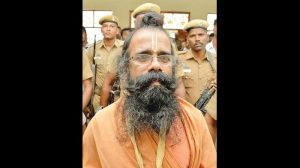
Tamil Nadu Governor Banwarilal Purohit has told the Supreme Court that a decision on the mercy petition of AG Perarivalan- a convict serving a life sentence for the assassination of former Prime Minister Rajiv Gandhi, will be taken within four weeks.
- The petition has been pending with the Governor since December 30, 2015.
- Citing inaction on part of the Governor in deciding on his clemency plea moved under Article 161 of the Constitution, Perarivalan has come to Supreme Court for passing necessary directions.
Article 161:
- Article 161 gives the Governor the “power to grant pardons, reprieves, respites or remissions of punishment or to suspend, remit or commute the sentence of any person convicted of any offence against any law relating to a matter to which the executive power of the state extends”.
Article 72 vs Article 161:
- The scope of the pardoning power of the President under Article 72 is wider than the pardoning power of the Governor under Article 161.
The power differs in the following two ways:
- The power of the President to grant pardon extends in cases where the punishment or sentence is by a Court Martial but Article 161 does not provide any such power to the Governor.
- The President can grant pardon in all cases where the sentence given is sentence of death but pardoning power of Governor does not extend to death sentence cases.
WHO funding:

The U.S. has resumed its funding for WHO as President Joe Biden shifts towards greater international cooperation in the fight against COVID-19.
- Last year, US President Donald Trump had put a hold on America’s funding to the World Health Organization, accusing it of becoming China-centric during the ongoing coronavirus pandemic.
- The US is the largest contributor to the WHO.
WHO funding:
There are four kinds of contributions that make up funding for the WHO. These are:
- Assessed contributions are the dues countries pay in order to be a member of the Organization. The amount each Member State must pay is calculated relative to the country’s wealth and population.
- Voluntary contributions come from Member States (in addition to their assessed contribution) or from other partners. They can range from flexible to highly earmarked.
- Core voluntary contributions allow less well-funded activities to benefit from a better flow of resources and ease implementation bottlenecks that arise when immediate financing is lacking.
- Pandemic Influenza Preparedness (PIP) Contributions were started in 2011 to improve and strengthen the sharing of influenza viruses with human pandemic potential, and to increase the access of developing countries to vaccines and other pandemic related supplies.
WHO’s current funding pattern:
- As of fourth quarter of 2019, total contributions were around $5.62 billion, with assessed contributions accounting for $956 million, specified voluntary contributions $4.38 billion, core voluntary contributions $160 million, and PIP contributions $178 million.
Taiwan’s de facto Ambassador to the U.S. was formally invited to President Joe Biden’s inauguration:
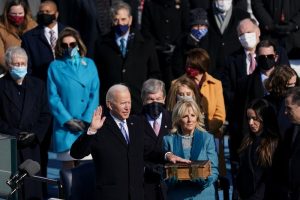
Taipei’s Foreign Ministry said it was the first time in decades that a Taiwanese envoy had been “invited” by the inauguration committee.
China- Taiwan relations:
- China has claimed Taiwan through its “one China” policy since the Chinese civil war forced the defeated Kuomintang, or Nationalist, to flee to the island in 1949 and has vowed to bring it under Beijing’s rule, by force if necessary.
- China is Taiwan’s top trading partner, with trade totalling $226 billion in 2018. Taiwan runs a large trade surplus with China.
- While Taiwan is self-governed and de facto independent, it has never formally declared independence from the mainland.
- Under the “one country, two systems” formula, Taiwan would have the right to run its own affairs; a similar arrangement is used in Hong Kong.
- Taiwan is a member of the World Trade Organization, Asia-Pacific Economic Cooperation and Asian Development Bank under various names.
Indo- Taiwan relations:
- Although they do not have formal diplomatic ties, Taiwan and India have been cooperating in various fields.
- India has refused to endorse the “one-China” policy since 2010.
New Arctic Policy:

India drafted a new Arctic policy that aims at expanding scientific research, sustainable tourism and exploration of mineral oil and gas in the Arctic region.
About the Policy:
- Nodal Body: India has designated Goa-based National Centre for Polar and Ocean Research to lead scientific research and act as a nodal body to coordinate among various scientific bodies to promote domestic scientific research capacities in the Arctic.
Objectives:
- Promoting Scientific Study of Arctic: Orient the curriculum on earth sciences, biological sciences, geosciences, climate change and space-related programmes with Arctic imperatives in Indian Universities.
- Planning Explorations: Formulating effective plans for Arctic-related programmes for mineral/oil and gas exploration in petroleum research institutes
- Promoting Arctic Tourism: Encouraging tourism and hospitality sectors by building specialised capacities and awareness by engaging with Arctic enterprises.
About the Arctic:
- The Arctic is a polar region located at the northernmost part of Earth.
- The Arctic consists of the Arctic Ocean, adjacent seas, and parts of Alaska (United States), Canada, Finland, Greenland (Denmark), Iceland, Norway, Russia, and Sweden.
- Land within the Arctic region has seasonally varying snow and ice cover.
Traffic Violation Premium:

A Working Group set up by the Insurance Regulatory and Development Authority of India (IRDAI) for Traffic Management has recently proposed to add a “traffic violation premium” to the vehicle insurance policy.
- Previously in September 2019, the IRDAI constituted the Working Group to examine the establishment of a system of Linking Motor Insurance Premium with Traffic Violations.
About the Premium:
- Vehicle owners may have to pay an insurance premium depending on the traffic violations involving the vehicle.
- The working group has recommended inserting a fifth section to motor insurance called “traffic violation premium” in addition to motor own damage insurance, basic third-party insurance, additional third party insurance, and compulsory personal accident premium.
Calculation of Premium:
- A system of calculating traffic violation points basis the frequency and severity of different traffic offenses.
- The amount of traffic violation premium will depend upon driving habits which will be determined by the number and types of challans.
- Traffic violation premium shall be payable by the registered owner of the vehicle, whether an individual or an entity.
Calculation of Points:
- As per the table of offences provided by the working group, drinking driving will attract the highest penalty of 100 points, while wrong parking will have 10 points penalty. The amount of premium will be linked to these penalty points.
Data Storage:
- The data of traffic challans will be stored by the National Informatics Centre (NIC) and shared with the Insurance Information Bureau of India (IIB) on a daily basis.
- IIB aims to provide information support in a Complete, Consistent, and Concise manner, to all stakeholders associated either directly or indirectly with the Insurance Sector, including Insurers, Regulator, and Government Agencies.
Mechanism:
- The premium is on the vehicle and not on the driver. This means when a new vehicle is bought, it will start with a clean traffic violation history and its owner, when buying motor insurance, will not need to pay any traffic violation premium, even if he has a past traffic violation history, either as a driver of a vehicle owned by another person or his own vehicle of similar or a different category.
- However, if a person renews motor insurance, s/he will be assessed for her/his traffic violation points and traffic violation premium s/he needs to pay.
- In case of transfer of insurance of a vehicle after the sale, the traffic violation premium would start from ground zero from the date of vehicle ownership transfer and build depending upon the traffic violations caused by the vehicle after ownership transfer.
Parakram Diwas:
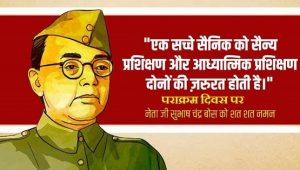
The central government has decided to observe Subhas Chandra Bose Jayanti as ‘Parakram Diwas’ to be celebrated on 23rd January.
- A high-level committee headed by the Prime Minister has also been formed to plan year-round programmes to mark the anniversary of Bose.
- Recently the Government of India has also instituted Subhash Chandra Bose Aapda Prabandhan Puraskaar to recognise the excellent work done by the individuals and institutions in the field of disaster management.
Subhas Chandra Bose was born on 23rd January 1897, in Cuttack, Orissa Division, Bengal Province, to Prabhavati Dutt Bose and Janakinath Bose.
- In 1919, he had cleared Indian Civil Services (ICS) examination. Bose, however, resigned later.
- He was highly influenced by Vivekananda’s teachings and considered him as his spiritual Guru.
- His political mentor was Chittaranjan Das.
Association with Congress:
- He stood for unqualified swaraj (independence), and opposed Motilal Nehru Report which spoke for dominion status for India.
- He actively participated in the Salt Satyagraha of 1930 and vehemently opposed the suspension of Civil Disobedience Movement and signing of the Gandhi-Irwin Pact in 1931.
- In the 1930s, he was closely associated with left politics in Congress along with Jawaharlal Nehru and M.N. Roy.
- Bose won the congress presidential elections at Haripura in 1938.
- Again in 1939 at Tripuri, he won the presidential elections against Gandhi’s candidate Pattabhi Sitarammayya. Due to ideological differences with Gandhi, Bose resigned and left congress. Rajendra Prasad was appointed in his place.
- He found a new party, ‘the Forward Bloc’.
- The purpose was to consolidate the political left and major support base in his home state Bengal.
Indian National Army:
- He reached Japanese-controlled Singapore from Germany in July 1943, issued from there his famous call, ‘Delhi Chalo’, and announced the formation of the Azad Hind Government and the Indian National Army on 21st October 1943.
- The INA was first formed under Mohan Singh and Japanese Major Iwaichi Fujiwara and comprised Indian prisoners of war of the British-Indian Army captured by Japan in the Malayan (present-day Malaysia) campaign and at Singapore.
- The INA included both, the Indian prisoners of war from Singapore and Indian civilians in South-East Asia. It’s strength grew to 50,000.
- The INA fought allied forces in 1944 inside the borders of India in Imphal and in Burma.
- In November 1945, a British move to put the INA men on trial immediately sparked massive demonstration all over the country.
English translation of poems of Sree Narayana Gurudev:

The Vice President of India has virtually launched “Not Many, But One”, an English translation of poems of Sree Narayana Gurudev.
Who was Sree Narayana Gurudev
- Sree Narayana Guru was born on 22nd August, 1856 to Madan Asan and his wife Kuttiyamma in Chempazhanthy, a village near Thiruvananthapuram, Kerala.
- His family belonged to the Ezhava caste and was considered ‘avarna’ according to the social mores of the time.
Right from his childhood he loved solitude and always indulged himself in deep contemplation. - He was intensely drawn to worship at the local temples and composed hymns and several devotional songs.
- From an early age, he was drawn towards asceticism. He lived as a hermit in a forest for eight years.
- He learned Vedas, Upanishads, literature, logical rhetoric of Sanskrit, Hatha Yoga and other philosophies.
Important Works:
- He gave the famous slogan “One Caste, One Religion, One God for All” (Oru Jathi, Oru Matham, Oru Daivam, Manushyanu).
- In 1888, he built a temple dedicated to Lord Shiva at Aruvippuram which was against the caste-based restrictions of the time.
- In one temple he consecrated at Kalavancode, he kept mirrors instead of idols. This symbolised his message that the divine was within each individual.
- He taught equality but felt the inequalities should not be exploited to carry out conversions and therefore generate strife in society.
- Narayana Guru organized an All-Region Conference in 1923 at Alwaye Advaita Ashram, which was reported to be the first such event in India.
- This was an effort to counter the religious conversions Ezhava community was susceptible to.
Philosophy of Sree Narayana Guru:
- Sree Narayana Guru became one of the greatest proponents and re-evaluators of Advaita Vedanta, the principle of non-duality put forward by Adi Shankara.
Literary Works:
- He wrote various books in different languages.
- Few of them are: Advaitha Deepika, Asrama, Thevarappathinkangal, etc.
Contribution to National Movement:
- A remarkable social reformer, he was in the forefront of the movement for universal temple entry and against the societal ills like the social discrimination of untouchables.
- Narayana Gurudev provided the impetus for Vaikom agitation which was aimed at temple entry in Travancore for the lower castes.
- It drew nationwide attention and appreciation from Mahatma Gandhi.
- He captured the essence of Indianness in his poems which highlighted the unity that lies beneath the world’s apparent diversity.
Contribution to Science:
- Emphasized the practice of ideals of cleanliness, promotion of education, agriculture, trade, handicrafts and technical training.
- Sree Narayana Gurudev’s Adyaropa darsana (Darsanamala) explains the creation of the universe.
- Daivadasakam and Atmopadesa satakam are a few examples of how the mystic reflections and insights closely resemble recent advances in physics.
Smart Anti-Airfield Weapon (SAAW):
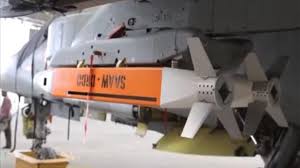
The Defence Research and Development Organisation (DRDO) has conducted a successful trial of the indigenously developed Smart Anti-Airfield Weapon (SAAW) off the Odisha coast from the Hawk-I jet of Hindustan Aeronautics Limited (HAL).
- This was the ninth successful test of the system conducted over the last five years.
- The system belongs to the glide bomb category and its development began around 2012-13, with crucial inputs from the Indian Air Force (IAF) and the first test was carried out in 2016.
- Manufactured by: DRDO’s Research Centre Imarat (RCI) Hyderabad.
Features:
- The weapon is designed to strike ground targets, especially adversary airfield infrastructure or similar strategically important installations.
- This is a 125-kilogram class smart weapon, capable of engaging ground enemy airfield assets such as radars, bunkers, taxi tracks, and runways, up to a range of 100 kilometres.
- The high precision guided bomb is lightweight compared to weapon systems of the same class.
Other Related Development:
- The test of SAAW comes months after another weapon system designed to target enemy radar and communication assets, Rudram, was tested in October 2020.
- Rudram, an air-to-surface missile, has been developed to primarily to enhance the Suppression of Enemy Air Defence (SEAD) capability of the IAF and can detect, track and neutralise the radar, communication assets and other radio frequency sources belonging to the adversary, which are generally their air defence systems.
24th “Hunar Haat”:
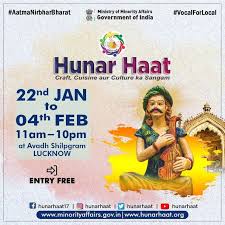
It is being organized in Lucknow (Uttar Pradesh) from 22nd January to 04th February, 2021.
Hunar Haat is an exhibition of handicrafts and traditional products made by artisans from the minority communities. The USTTAD scheme aims to promote and preserve the rich heritage of the traditional arts & crafts of the minority communities. It envisages boosting the skills of craftsmen, weavers and artisans who are already engaged in the traditional ancestral work.
- Theme: Vocal for Local.
- Organizer: These are organised by the Ministry of Minority Affairs under USTTAD (Upgrading the Skills & Training in Traditional Arts/Crafts for Development) scheme.
- Aim: These Haat aims to provide market exposure and employment opportunities to artisans, craftsmen and traditional culinary experts.
Joymoti Konwari:

Prime Minister Narendra Modi is scheduled to visit Assam on January 23. The venue for Modi’s program is the historic Jerenga Pothar in Upper Assam’s Sivasagar district.
- Formerly known as Rangpur, Sivasagar was the seat of the powerful Ahom dynasty, which ruled Assam for six centuries (1228-1826).
- Jerenga Pothar, an open field in Sivasagar town, is popularly connected to the valour of 17th century Ahom princess Joymoti.
- The place Joymoti was tortured to death was Jerenga Pothar.
Joymoti Konwari:
- Joymoti Konwari, was the wife of Tai-Ahom Prince Gadapani (later Supatphaa).
- She was accorded the honorific Mohiyokhi on account of her heroic endurance of torture until the end, dying at the hands of royalists under Sulikphaa Loraa Roja without disclosing her exiled husband Prince Gadapani’s whereabouts, thereby enabling her husband to rise in revolt and assume kingship.
- Gadapani and Joymoti’s son Rudra Singha had the Joysagar Tank dug at the spot where she was tortured.
ShramShakti:

The Union Minister of Tribal Affairs launched “ShramShakti”, a National Migration Support Portal at a program held at Panjim, Goa.
- It would effectively help in the smooth formulation of state and national level programs for migrant workers.
- The tribal migration repository, ShramShakti would be able successfully able to address the data gap and empower migrant workers who generally migrate in search of employment and income generation.
- The various data that will be recorded via Shram Shakti include demographic profile, livelihood options, skill mapping, and migration pattern.
- He also launched a tribal migration cell, a tribal museum at Goa, and “ShramSaathi”, a training manual for migrant workers.
- With this, Goa is going to be the first destination state of India to set up a dedicated migration cell to address diverse issues of migrant workers.




